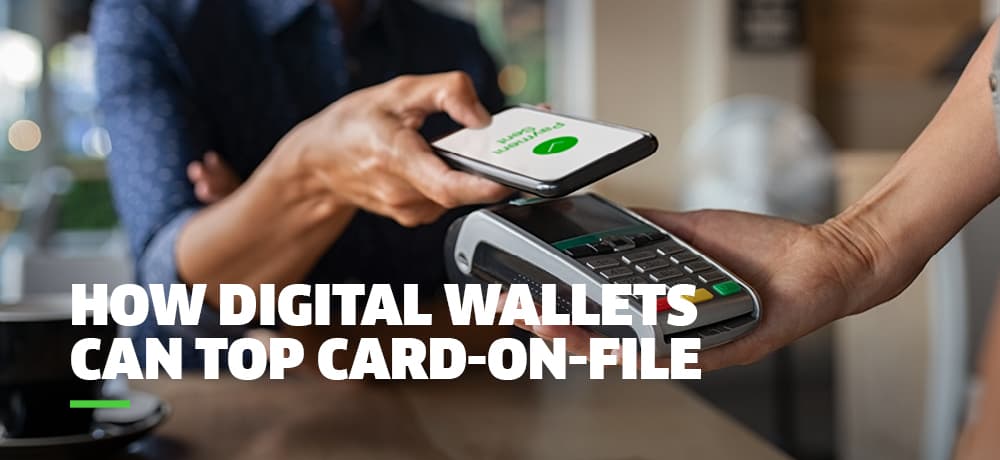Fintech Insights
Advantages of digital wallets help them rise above card-on-file payments
Rami Josef | senior product manager, Worldpay
April 04, 2022

Digital wallets have been trending for years, but adoption increased during the COVID-19 pandemic. Worldpay research shows that the average transaction value of a digital wallet transaction in the U.S. is 25% higher than a typical card transaction. Additionally, digital wallet usage grew even at the point of sale, rising over 21% in 2021. Globally, more than half of all e-commerce transactions are expected to be made with a digital wallet by 2023, according to Worldpay’s Global Payments Report.
As digital wallets outpace cards in transaction acceptance rates, what can digital wallets do to improve the checkout experience as businesses look to a post-pandemic future?
Digital wallets offer a smoother e-commerce experience
One of the primary advantages digital wallets offer is a smooth e-commerce experience with fewer clicks to check out. For example, when a business implements the Google Pay digital wallet in its app or website, customers can check out using the payment information securely stored in their Google account. With fewer steps required, customers are more likely to complete their purchases and not abandon their shopping carts.
Take advantage of enhanced security with digital wallets
Digital wallet solutions that incorporate advanced security solutions like tokenization and biometric authentication help reduce the threat of fraud and chargebacks. By using a card token instead of the actual card number, a digital wallet solution like Google Pay encrypts and secures stored customer information in transit and at rest.
When we compare chargeback rates between cards and digital wallets, Worldpay research shows that digital wallets have a 99.6% lower chargeback volume than card transactions. While Worldpay processes significantly more volumes for cards, the reduced chargeback trend still stands as some card schemes offer a liability shift for using digital wallets, and friendly fraud is reduced with biometric 2FA authentication for digital wallet transactions.
Digital wallets benefit from increased acceptance
A digital wallet that uses card tokens along with advanced customer authentication leads to higher transaction approval rates than card-on-file transactions. With a solution like Google Pay, saved payment methods continue to work even when a card is replaced. This kind of payment flexibility means businesses can protect their revenue by avoiding the customer churn that results from lost, stolen and expired cards. Customer satisfaction increases, and businesses are saved the hassle of continually updating customer cards.
Globally, Worldpay data shows an acceptance uplift of digital wallets like Google Pay over traditional card entry. This is due to two factors:
- Issuers are sending fewer errors for expired cards, because digital wallets utilize EMVCo payment tokenization standards that allow issuers to renew the underlying card details without invalidating the credentials merchants use secondly.
- There are fewer upfront errors from invalid data because digital wallet providers present consistent validation before the data is stored in the digital wallet.
The advantages digital wallets have over cards
Streamlined checkout, advanced security protocols and higher acceptance rates are among the top benefits digital wallets offer businesses. These advantages are driving acceptance: merchant adoption of digital wallets over the past 12 months has increased 43%
Outside the U.S., card-on-file transaction values are typically larger than digital wallet transactions. This discrepancy is attributed to a misconception that digital wallets can only be used for low-value transactions. This is due in part to the fact that more “everyday spending” businesses with lower average transaction values are accepting digital wallets.
As digital wallet adoption and acceptance become more common around the world and consumers realize they can pay with a digital wallet for online transactions of any amount up to their credit limit, the average global transaction amount is expected to surpass that of card-on-file. Additionally, with issuers keeping cards updated in the background, businesses gain efficiency and cost savings they wouldn’t without wallet acceptance.
Digital wallet implementation and best practices
Lack of familiarity is one reason some businesses bypass digital wallet acceptance. Many are not aware of the benefits and have concerns about implementation. Businesses may be surprised to learn that the process of adding a digital wallet solution like Google Pay is actually quite easy. Once a business launches a digital wallet acceptance solution, following some simple guidelines helps enhance the customer experience.
Digital wallet best practices include:
- Introduce digital wallets like Google Pay as early in the checkout journey as possible, e.g., on the product or basket page.
- Use APIs like Google Pay’s ReadyToPay API to set up defaults.
- Set automatic price updates.
- Integrate with Worldpay’s payment gateway that handles decryption of wallet payload and processing, ensuring a fast live-to-market implementation.
Getting started with digital wallets
As you evaluate options for adding digital wallet acceptance to your business, be sure to download your copy of, “Why Digital Wallets Pocket More for Businesses - and How to Bring Them Online.”
This new whitepaper was created in partnership between Google and Worldpay and covers the features, benefits and implementation of digital wallets in general and Google Pay in particular. Download now.
Editor’s note: This article was originally published in November 2020. It has been updated for accuracy and consistency.
